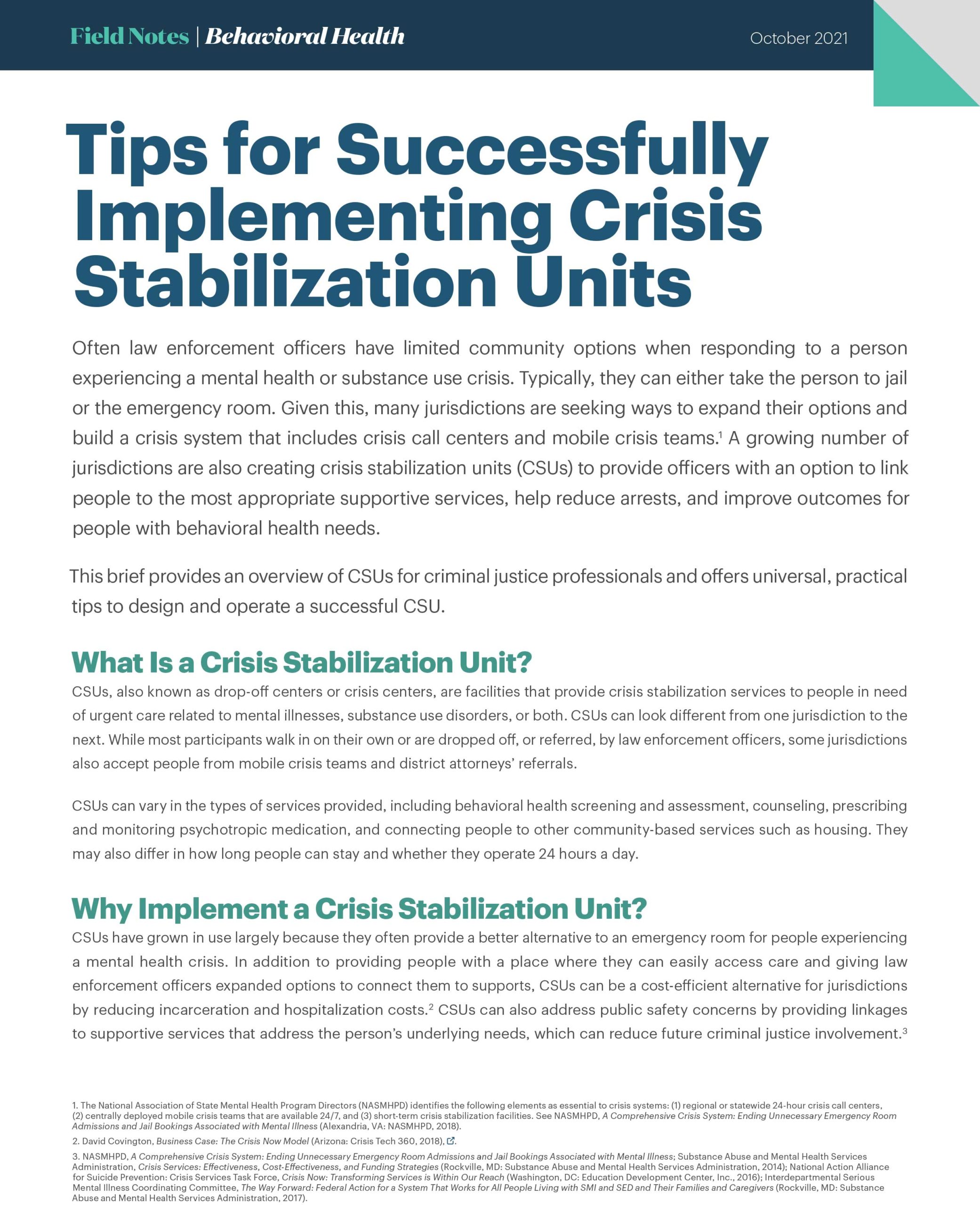Tips for Successfully Implementing Crisis Stabilization Units
A growing number of jurisdictions are creating crisis stabilization units (CSUs) to provide officers with an option to link people to the most appropriate supportive services, help reduce arrests, and improve outcomes for people with behavioral health needs. This brief provides an overview of CSUs for criminal justice professionals and offers universal, practical tips to design and operate a successful CSU. Photo credit: CDC on Unsplash
Tips for Successfully Implementing Crisis Stabilization Units
Often law enforcement officers have limited community options when responding to a person experiencing a mental health or substance use crisis. Typically, they can either take the person to jail or the emergency room. Given this, many jurisdictions are seeking ways to expand their options and build a crisis system that includes crisis call centers and mobile crisis teams.1 A growing number of jurisdictions are also creating crisis stabilization units (CSUs) to provide officers with an option to link people to the most appropriate supportive services, help reduce arrests, and improve outcomes for people with behavioral health needs.
This brief provides an overview of CSUs for criminal justice professionals and offers universal, practical tips to design and operate a successful CSU.
What Is a Crisis Stabilization Unit?
CSUs, also known as drop-off centers or crisis centers, are facilities that provide crisis stabilization services to people in need of urgent care related to mental illnesses, substance use disorders, or both. CSUs can look different from one jurisdiction to the next. While most participants walk in on their own or are dropped off, or referred, by law enforcement officers, some jurisdictions also accept people from mobile crisis teams and district attorneys’ referrals.
CSUs can vary in the types of services provided, including behavioral health screening and assessment, counseling, prescribing and monitoring psychotropic medication, and connecting people to other community-based services such as housing. They may also differ in how long people can stay and whether they operate 24 hours a day.
Why Implement a Crisis Stabilization Unit?
CSUs have grown in use largely because they often provide a better alternative to an emergency room for people experiencing a mental health crisis. In addition to providing people with a place where they can easily access care and giving law enforcement officers expanded options to connect them to supports, CSUs can be a cost-efficient alternative for jurisdictions by reducing incarceration and hospitalization costs.2 CSUs can also address public safety concerns by providing linkages to supportive services that address the person’s underlying needs, which can reduce future criminal justice involvement.3
Four Tips for a Successful Crisis Stabilization Unit
1. Make sure a CSU is what your jurisdiction needs.
A major part of ensuring your CSU is successful is first understanding whether it is the intervention your community needs. Conducting an assessment of your criminal justice and behavioral health systems can identify any gaps in your crisis services. Often, this assessment comes from completing a systems mapping exercise to help you identify how many people are not being served, what interventions are best suited for your jurisdiction, and what stakeholders you need to engage to design and implement these interventions. Note: even if you already have interventions such as mobile crisis teams and crisis call centers in place, your assessment may determine that a CSU is needed.
2. Build consensus and leadership buy-in.
Establishing agreement among key stakeholders is critical to successful implementation and operation. Stakeholders may vary by jurisdiction, but typically include law enforcement representatives, behavioral health providers, elected officials, criminal justice advocates, mental and behavioral health advocacy groups, and people who have been directly impacted by the mental health and criminal justice systems. Stakeholders should also include community members where the CSU will be located. Through stakeholder meetings, you can work to establish buy-in and help inform critical decisions.
3. Create an operations plan.
Creating a plan for how the CSU will operate helps set clear expectations and align partners and stakeholder goals. This includes establishing plans on (1) building location, design, and capacity; (2) hours of operation; (3) staffing and supervising structure; (4) target population and eligibility; (5) referral, admission, intake, and discharge processes; (6) services provided; (7) funding and sustainability; and (8) data and evaluations used to measure progress.
When developing these plans, it is essential that law enforcement leadership is centrally involved from the beginning to help ensure success.
4. Consider a phased funding approach.
Even if your jurisdiction has limited funds, there are still ways to ensure success. One approach is to begin operations with standard business hours and with limited, primary staffing. Upon securing more financial resources, hours of operation, staff, and service capacity can then be expanded. While CSUs are typically funded by local and state governments, jurisdictions should also explore the use of federal government and private funding. Understanding federal and state Medicaid laws and other health insurance reimbursement claims is key to identifying the services that can be billed through these additional funding efforts.4
Example of Success
Athens-Clarke County, Georgia used Justice and Mental Health Collaboration Program funding to partner with the local Behavioral Health Crisis Center (BHCC) to reduce the prevalence of people with SMI in their county jail. The BHCC features a three-pronged approach: (1) a crisis walk-in unit that is open 24/7 and staffed by certified peers; (2) a temporary observation unit, where people can stay for up to 23 hours; and (3) a crisis stabilization unit, where people stay 7 days on average. It also serves as a diversion option for law enforcement and a crisis management facility for the community, with the crisis stabilization unit discharging 100 percent of the people it receives to safe environments with referrals to community care.5
Request Free Support
If your jurisdiction is interested in learning more about CSUs or other efforts to support justice and mental health collaborations, visit the Center for Justice and Mental Health Partnerships for in-depth subject matter expertise. The center offers free training, resources, and specialized support to communities wanting to improve outcomes or enhance current responses for people in their criminal justice systems who have a mental illness or co-occurring substance use disorder.
Footnotes
1 The National Association of State Mental Health Program Directors (NASMHPD) identifies the following elements as essential to crisis systems: (1) regional or statewide 24-hour crisis call centers, (2) centrally deployed mobile crisis teams that are available 24/7, and (3) short-term crisis stabilization facilities. See NASMHPD, A Comprehensive Crisis System: Ending Unnecessary Emergency Room Admissions and Jail Bookings Associated with Mental Illness (Alexandria, VA: NASMHPD, 2018).
2 David Covington, Business Case: The Crisis Now Model (Arizona: Crisis Tech 360, 2018), http://bhltest2.com/wp-content/uploads/2018/05/CrisisNow-BusinessCase.pdf.
3 NASMHPD, A Comprehensive Crisis System: Ending Unnecessary Emergency Room Admissions and Jail Bookings Associated with Mental Illness; Substance Abuse and Mental Health Services Administration, Crisis Services: Effectiveness, Cost-Effectiveness, and Funding Strategies (Rockville, MD: Substance Abuse and Mental Health Services Administration, 2014); National Action Alliance for Suicide Prevention: Crisis Services Task Force, Crisis Now: Transforming Services is Within Our Reach (Washington, DC: Education Development Center, Inc., 2016); Interdepartmental Serious Mental Illness Coordinating Committee, The Way Forward: Federal Action for a System That Works for All People Living with SMI and SED and Their Families and Caregivers (Rockville, MD: Substance Abuse and Mental Health Services Administration, 2017).
4 The Council of State Governments (CSG) Justice Center offers tools to help with financial sustainability through its resource, Financing the Future of Local Initiatives. See, “Financing the Future of Local Initiatives,” CSG Justice Center, accessed October 30, 2020, https://csgjusticecenter.org/resources/funding/; NASMHPD’s Crisis Resource Calculator can help estimate the flow and cost of a jurisdiction’s crisis service system. See “Crisis Now: Transforming Crisis Services,” NASMHPD, accessed October 30, 2020, https://crisisnow.com/.
5 Laura Alexander, outcomes coordinator of Advantage Behavioral Systems, email message to the CSG Justice Center, April 30, 2021.
Project Credits
Writing: Demetrius Thomas, CSG Justice Center
Research: Demetrius Thomas and Marilyn Leake, CSG Justice Center
Editing: Darby Baham and Emily Morgan, CSG Justice Center
Design: Michael Bierman
Public Affairs: Ruvi Lopez, CSG Justice Center
Web Development: Eleventy Group
This project was supported by Grant No. 2019-MO-BX-K001 awarded by the Bureau of Justice Assistance. The Bureau of Justice Assistance is a component of the Department of Justice’s Office of Justice Programs, which also includes the Bureau of Justice Statistics, the National Institute of Justice, the Office of Juvenile Justice and Delinquency Prevention, the Office for Victims of Crime, and the SMART Office. Points of view or opinions in this document are those of the author and do not necessarily represent the official position or policies of the U.S. Department of Justice.
ABOUT THE AUTHOR
The sharp rise in school shootings over the past 25 years has led school officials across the U.S.…
Read More Taking the HEAT Out of Campus Crises: A Proactive Approach to College Safety
Taking the HEAT Out of Campus Crises: A Proactive Approach to College Safety
The sharp rise in school shootings over the past 25 years has…
Read More From 911 to 988: Salt Lake City’s Innovative Dispatch Diversion Program Gives More Crisis Options
From 911 to 988: Salt Lake City’s Innovative Dispatch Diversion Program Gives More Crisis Options
A three-digit crisis line, 988, launched two years ago to supplement—not necessarily…
Read More Matching Care to Need: 5 Facts on How to Improve Behavioral Health Crisis Response
Matching Care to Need: 5 Facts on How to Improve Behavioral Health Crisis Response
It would hardly be controversial to expect an ambulance to arrive if…
Read More












